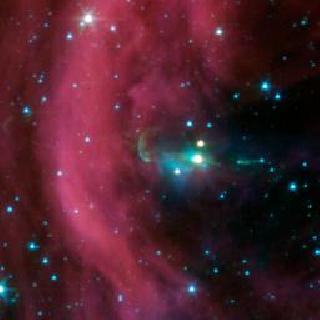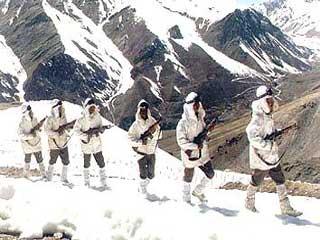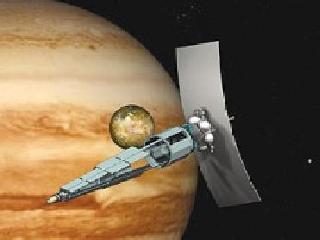
NASA's Spitzer Space Telescope took this image of a baby star sprouting two identical jets (green lines emanating from fuzzy star. Photo by NASA/JPL-Caltech.
PASADENA, CALIFORNIA (BNS): Astronomers have discovered that two symmetrical jets shooting away from opposite sides of a blossoming star are experiencing a time delay - knots of gas and dust from one jet blast off four-and-a-half years later than identical knots from the other jet.
The discovery of the time delay, in the jets called Herbig-Haro 34, which required the infrared vision of NASA's Spitzer Space Telescope, is helping astronomers understand how jets are produced around forming stars, including those resembling our sun when it was young, NASA said.
"More studies are needed to determine if other jets have time delays," said Alberto Noriega-Crespo of NASA's Spitzer Science Center at the California Institute of Technology in Pasadena, who is a co-author of the new study.
"Now we know that in at least one case, there appears to be a delay, which tells us that some sort of communication may be going on between the jets that take time to occur."
Jets are an active phase in a young star's life. A star begins as a collapsing, roundish cloud of gas and dust. By ejecting supersonic jets of gas, the cloud slows down its spinning. As material falls onto the growing star, it develops a surrounding disk of swirling material and twin jets that shoot off from above and below the disk, like a spinning top.
Once the star ignites and shines with starlight, the jets will die off and the disk will thin out. Ultimately, planets may clump together out of material left in the spinning disk.
"Where we stand today on Earth was perhaps once a very violent place where high-velocity gas and dust were ejected from the disk circling around our very young sun," said Alex Raga of the Universidad Nacional Autónoma de México, the first author of the paper.
"If so, the formation of planets like Earth depends on how and when this phenomenon ended. Essentially, every star like our own sun has gone through a similar cloud-disk-jets formation process," he said.
Spitzer images show that the newfound jet is perfectly symmetrical to its twin, with identical knots of ejected material. This symmetry turned out to be key to the discovery of the jets' time delay.
By measuring the exact distances from the knots to the star, the astronomy team was able to figure out that, for every knot of material punched out by one jet, a similar knot is shot out in the opposite direction 4.5 years later.
This calculation also depended on the speed of the jets, which was known from previous studies by NASA's Hubble Space Telescope.
 Previous Article
Previous Article Next Article
Next Article











The Indian Air Force, in its flight trials evaluation report submitted before the Defence Ministry l..
view articleAn insight into the Medium Multi-Role Combat Aircraft competition...
view articleSky enthusiasts can now spot the International Space Station (ISS) commanded by Indian-American astr..
view article